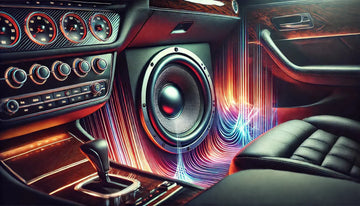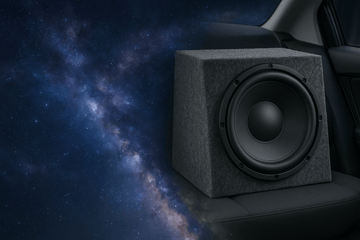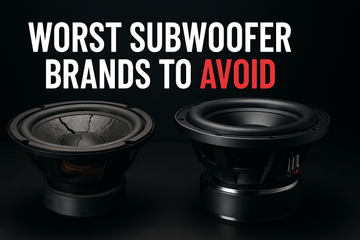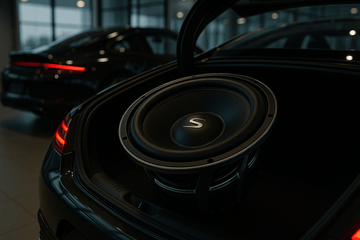Putting a subwoofer in the right spot in your car is really important if you want the best sound and bass. The placement of a car subwoofer is influenced by the car interior and the vehicle's interior design, as these factors affect how sound waves travel and how bass is experienced.
When we talk about bass frequencies, these are parts of music that don’t seem to come from any specific direction, unlike higher sounds.
To figure out where to put your subwoofer, you need to think about how much room you have in your car, what kind of bass sound you’re after, and how much space there is in the trunk.
Most car subwoofers are installed in the car trunk because the available trunk space allows for larger enclosures and better sound reflection, but different locations—such as under the seat or on the rear parcel shelf—can be considered for the best placement depending on your needs.
A lot of people choose either under their seat, somewhere in the trunk, or even behind the seat subwoofer solutions for installing their subwoofers, but the best place for optimal sound quality is typically at the rear end of your vehicle facing back.
When setting up your subwoofer, avoid placing it too close to walls or in corners, as this can cause boomy or muddy bass. Experimenting with placement in different locations within your vehicle's interior will help you achieve the best results.
Introduction
Subwoofers really make a difference in how your car’s audio system sounds, giving you that deep bass that makes the music feel more alive. A subwoofer also enhances the overall sound system, complementing your existing speakers and creating a more immersive listening experience. But it’s not just about having one; the subwoofer‘s position in your car matters a lot for sound quality and how much you enjoy listening to music. In this blog, we will dive into why subwoofer placement is crucial and look at all the places you can put it.
When deciding where to place a subwoofer, there are many things to consider. Your listening position, room for the enclosure, and the specific frequency response you want all affect where it should go. As a general rule, experimenting with sub placement is key to achieving the best sound. Additionally, room modes inside the vehicle and overall room dimensions influence the best spot for optimal sound. How your car is designed could change how well certain spots work for the subwoofer.
By understanding how subwoofer placement affects audio quality and exploring various options, you’ll be able to choose wisely where your subwoofer goes best. When installing a new subwoofer, it's important to test different positions to find the optimal spot. Whether sticking with something traditional like mounting it in the trunk, slipping it under a seat, or even coming up with unique custom setups, this post has some valuable tips and insights for ensuring you get accurate bass in your ride.
The Impact of Subwoofer Placement on Sound Quality
Where you put a subwoofer in your car really matters for how good the music sounds. Subwoofers are all about bringing out the low frequencies, making songs feel fuller and richer. Proper placement can further enhance lower frequencies for a deeper, fuller sound. Depending on the position of the subwoofer, it can change how you hear these bass sound waves.
With the right placement, everything in music clicks better. The bass feels strong but not too overpowering; it’s like you’re inside the song itself. However, poor placement can lead to some parts of a song sounding louder than others or creating unwanted room modes and dead spots that mess with good bass quality. This can affect how the sweet spot for listening feels, diminishing the experience. The orientation of the subwoofer and the point at which it is aimed are important for optimizing bass response and overall sound quality.
For the best audio experience in your car, think about consistent bass distribution. Aligning the subwoofer well with other main speakers makes sure every part of the track—from high notes to deep beats—comes through clearly. Room correction software can also be handy for fine-tuning the response.
Exploring How Subwoofer Location Affects Bass Response
Where you put the subwoofer in your car really matters for how good the bass and overall sound quality will be. It’s all about how bass sound waves travel and room modes come into play.
A common choice is to place the subwoofer in the trunk, especially if you’re working with a large space. This creates a boomy effect, fully utilizing amplifier power to push deep low frequencies. Facing the subwoofer toward the rear seat can often enhance bass response and improve overall sound quality. Placing the subwoofer under a seat, on the other hand, can offer a more accurate bass experience due to being closer to the listening position.
Corner placement is another consideration. Like setting up a home theater, putting the subwoofer in the corner of the trunk can boost low frequencies but might need room correction to avoid overemphasis. Experimenting with locations—doing a subwoofer crawl around the interior and trying different directions for the subwoofer—can help identify the best spot for that consistent bass response without annoying dead spots.
BMW Subwoofer System
Why Correct Subwoofer Placement Matters for an Optimal Audio Experience
The subwoofer’s position is key to getting great sound in your car. When you place the subwoofer correctly, not only does the bass sound better, but it also improves the overall speaker system. Proper placement avoids tripping hazards and boomy resonances by allowing even distribution across room dimensions.
Besides better bass, placing the subwoofer right also prevents buzzing or rattling from other parts of the car. This means a cleaner, more balanced sound, free of distortion. The position of the subwoofer relative to the rear seats can significantly affect bass clarity and overall sound quality, as the rear seat fabric and placement influence how sound waves travel through the cabin. Proper alignment, much like fine-tuning a home theater setup, transforms a decent system into an immersive experience where every beat hits with impact.
Choosing the Right Subwoofer
Selecting the right subwoofer is a key step in building a car audio system that delivers impressive sound quality and deep, powerful bass. A quality subwoofer can transform your listening experience, adding richness and depth to your music that standard speakers just can’t match. When choosing a subwoofer, pay close attention to its power handling, sensitivity, and frequency range—these factors determine how well it will perform with your existing audio system and how much impact it can deliver.
Look for a subwoofer that matches your car’s interior and your personal music preferences. Check the RMS power rating to ensure it can handle the output from your amplifier without distortion. Impedance and frequency response are also important; they affect how the subwoofer integrates with your audio setup and how well it reproduces low frequencies. Balancing these specifications with your budget and available space will help you achieve optimal performance and sound quality. Ultimately, the right subwoofer will bring your car audio system to life, making every drive more enjoyable.
Subwoofer Enclosure Design
A well-designed subwoofer enclosure is essential for getting the most out of your car audio system. The enclosure not only houses the subwoofer but also plays a major role in shaping the sound quality and depth of the bass. Whether you opt for a custom-built enclosure or a pre-made one, it’s important to consider space limitations, the type of materials used, and the acoustics of your vehicle.
Custom enclosures allow you to tailor the fit and sound to your specific needs, making the most of your car’s available space and unique interior. Pre-made enclosures, on the other hand, offer convenience and a professional finish, ensuring your subwoofer is securely mounted and performs at its best. The right enclosure design will help your subwoofer produce deep bass and clear sound, making it an essential part of any high-quality car audio system.
Creating a Subwoofer Box
Building a subwoofer box requires careful consideration to achieve the best possible sound quality and optimal performance. Start by selecting the right size and shape for your subwoofer box design, taking into account the subwoofer’s power requirements and the available space in your vehicle. The box should be designed to minimize unwanted vibrations and resonance, which can muddy the bass and reduce overall sound clarity.
Use sturdy materials and ensure all joints are properly sealed to prevent air leaks, which can impact the subwoofer’s ability to reach its full potential. Pay attention to the port size and shape if you’re building a ported enclosure, as this will affect how the bass sounds. A well-constructed subwoofer box is essential for delivering deep, powerful bass and enhancing the overall sound quality of your car audio system.
How does the placement of a subwoofer affect the overall audio experience?
The placement of a subwoofer in a car can significantly impact the audio experience. Placing it in the trunk can enhance bass production and create a more balanced sound; however, installing a subwoofer in the trunk can reduce available cargo space, so it's important to balance sound quality with your storage needs. Placement near the back seats can provide a surround effect, enveloping passengers in music for an immersive listening experience.
Popular Subwoofer Placement Options in Cars
When figuring out subwoofer placement, a few popular options exist. A trunk setup is traditional because space and room modes allow deeper bass. An under-seat setup keeps things compact, with the subwoofer close to the listening position for a more personal bass response. Some might even use the front corners or the rear deck for a distinct bass effect.
If you have a second subwoofer, try different combinations, like placing one in the trunk and one under a seat. This setup helps achieve consistent bass and can address dead spots often found in car interiors.
Before starting installation, make sure you have the right tools ready for measuring and positioning the subwoofer. Using proper tools ensures accurate placement and optimal sound quality.
Kicker Solo X 15” Subwoofer System | Audio Intensity
Should Your Subwoofer Face Front or Back?
Deciding whether your subwoofer should face the front or back affects how low frequencies behave. Facing the subwoofer backward can allow the bass to build up off the back wall, providing a fuller, stronger effect. Facing forward might be best in a large space if you prefer bass that’s directly focused on the listening position. Experimenting with sub placement and orientation can help you achieve the desired bass effect, as different positions can significantly impact sound quality and bass response.
The choice often comes down to personal preference and the type of bass experience you want. Some home theater principles, like making use of room dimensions and corner placement, apply here as well. Experimenting with these options will help you find what sounds best in your car.
How Car Design Influences Subwoofer Effectiveness
The layout and design of your car also play into subwoofer placement. Vehicles with larger room dimensions, like SUVs, might benefit from positioning the subwoofer in front corners to take advantage of acoustics similar to a home theater setup. Compact cars, on the other hand, might have fewer choices but benefit greatly from consistent bass using room correction.
Customizing the subwoofer's position based on your car's unique features, whether under a seat, in a corner, or fitted along a back wall, is key to achieving accurate bass without overwhelming the space.
Innovative Subwoofer Placement Ideas
For those thinking outside the box, subwoofer placement can get creative. Custom enclosures that fit into the middle of the room or even within the front wall of the vehicle offer both style and improved sound. Trying a repeating bass line to find the ideal placement and testing with a microphone to calibrate for consistent bass can be game-changing in getting that clean, powerful response.
Setting Up Your Subwoofer: Essential Tips
To get the most out of your subwoofer and ensure it works well with your main speakers, follow these essential tips:
-
Subwoofer crawl: Move the subwoofer around to find the spot where bass response is most even.
-
Room correction software: Use this to fine-tune the frequency response and eliminate dead spots.
-
Phase alignment and crossover settings: Properly set these to ensure the sub blends seamlessly with the main speakers.
By optimizing these aspects of subwoofer placement, you'll achieve accurate bass that enhances your car audio without overwhelming it.
Subwoofer Setup Techniques for Enhanced Sound
For an enhanced audio experience, consider employing subwoofer setup techniques. Experiment with subwoofer crawl to find the best spot in your car, maximizing bass response. Utilize room correction software to optimize sound quality. Placing the sub in the front corners or near the listening position can greatly enhance bass performance. Additionally, adding a second subwoofer can balance out bass frequencies for a more immersive sound. Try different placements and configurations to achieve the best possible audio outcome.
Personalizing Your Subwoofer
Personalizing your subwoofer setup is all about fine-tuning the sound to match your preferences and your car’s unique interior. Start by adjusting the subwoofer’s volume, crossover, and phase controls to achieve the best sound quality and bass response for your favorite music. Experiment with different subwoofer positions and orientations within your vehicle to find the optimal placement that delivers the best sound quality and bass impact.
Consider the layout of your car’s interior, the seating arrangement, and the available space when deciding on the subwoofer position. By taking the time to personalize your subwoofer, you can create a custom listening experience that brings out the best in your car audio system, ensuring every drive is filled with rich, balanced sound.
Troubleshooting Common Issues
Even the best car audio systems can run into issues, so troubleshooting your subwoofer is essential for maintaining optimal performance and sound quality. If you notice weak bass, distorted sound, or rattling noises, start by checking all connections between the subwoofer, amplifier, and head unit to ensure they are secure and properly installed. Adjusting the amplifier’s gain and low-pass filter can often resolve sound quality problems.
If your subwoofer or amplifier is overheating, make sure they have adequate ventilation and aren’t being pushed beyond their rated power limits. Persistent issues may require professional help to diagnose and fix, ensuring your subwoofer operates at its full potential. Regular maintenance and inspection of your car audio system will help prevent problems and keep your subwoofers delivering powerful, clear bass for years to come.
Conclusion
Finding the ideal subwoofer placement is critical for maximizing sound quality in your car. Considering the room dimensions, using techniques like the subwoofer crawl, and understanding the impact of room modes can help you choose the best spot for consistent and accurate bass. Fine-tuning settings such as crossover points and phase alignment further improves how your sub integrates with the rest of your speaker system. You'll achieve that perfect balance with proper setup, turning every car ride into a satisfying audio journey.
What is the Best Position for a Subwoofer in a Small Car?
When finding the perfect spot for a subwoofer in a small car, you’ve got to think about how much room you have and what kind of sound quality you’re after. Many people put it in the trunk or tuck it under the front seats. These spots are favorites because they can really boost that bass and improve your overall sound experience. In most cases, these locations provide the best balance of sound quality and space efficiency.
Can I Place a Subwoofer Under the Front Passenger Seat?
Sure, if your car has enough room and the design allows it, you can put a subwoofer under the front passenger seat. This spot is pretty handy because it doesn't fill up your trunk but still lets you enjoy a great sound experience. Just make sure to install it correctly and think about how comfy the seat will be with it underneath.
How Does Subwoofer Orientation Affect Sound Quality?
The way you set up your subwoofer matters when it comes to the sound quality. If you put the subwoofer so it faces the back of your car, you might notice that the bass sounds better, making your audio experience feel more all-encompassing. This happens because the sound waves bounce off from behind, making those deep bass frequencies stronger.
Are Wireless Subwoofers a Good Option for Cars?
Wireless subwoofers are a handy choice for car audio setups. They eliminate the need for complex wiring, making it easier to place your subwoofer wherever you want in the car. But when considering this option, keep in mind that how good they sound and how dependable their wireless connection is can really depend on the type of technology they use. On the other hand, wired subwoofers tend to be more reliable and consistent in performance.





